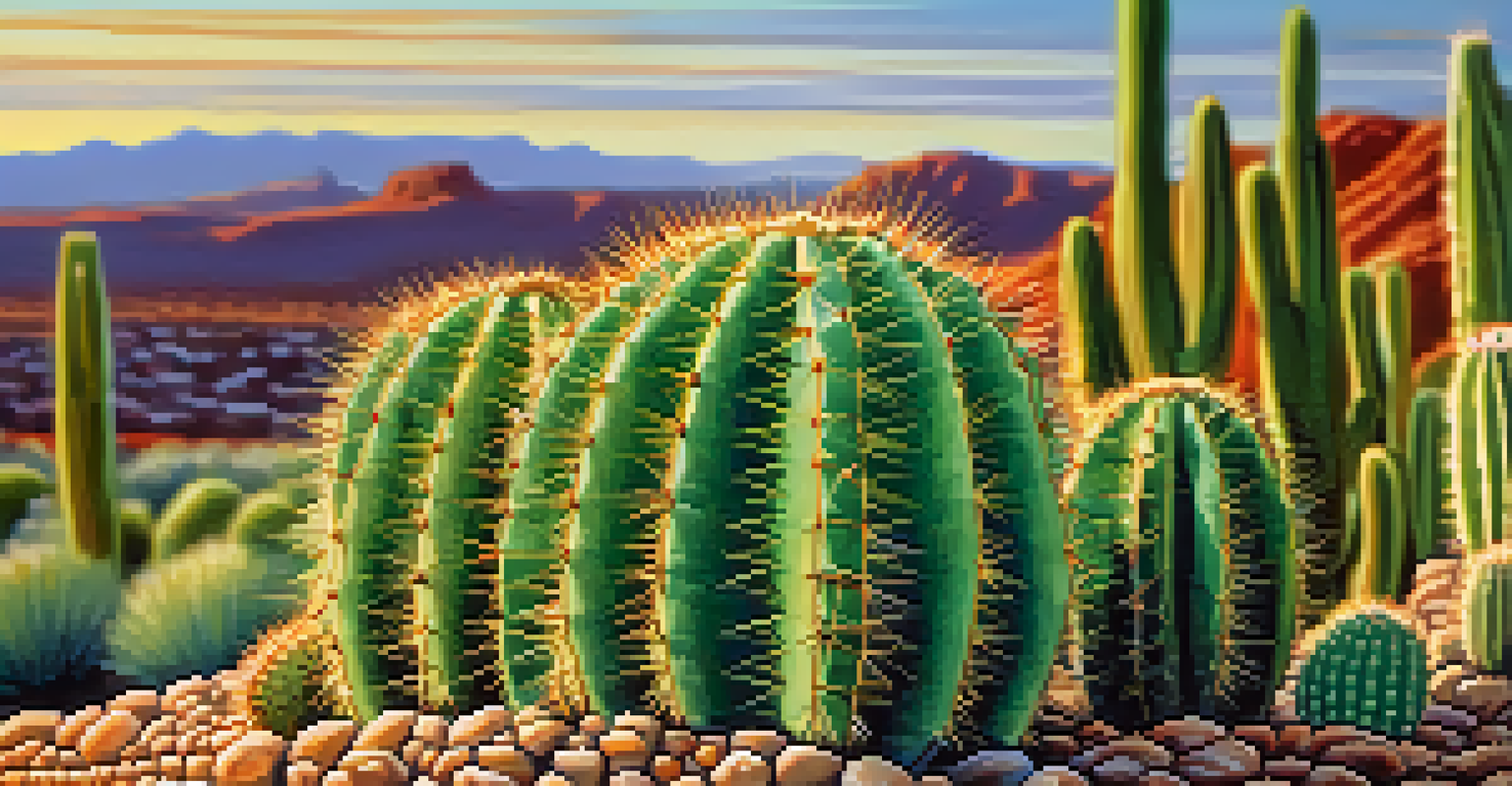Peyote and Ecological Concerns for Indigenous Communities

Introduction to Peyote and Its Cultural Significance
Peyote, a small cactus native to the Chihuahuan Desert, holds profound cultural and spiritual significance for many Indigenous communities, particularly the Native American Church. For centuries, it has been used in religious ceremonies, symbolizing a connection to the divine and nature. This sacred plant is not just a tool for spiritual exploration but also a source of identity and tradition for these communities.
The plant is a part of our identity, our way of life, and our connection to the divine.
However, the increasing interest in peyote, driven by its psychoactive properties, raises concerns about its sustainability and the impact on Indigenous practices. As more people seek to experience peyote, the pressure on its natural habitats grows, posing a threat to the very existence of this vital plant. This situation underscores the need for a responsible approach to both its use and conservation.
Understanding the intricate relationship between Indigenous peoples and peyote is crucial. It's not merely about consumption; it embodies a deeper connection to their heritage and the environment. As we delve into the ecological concerns surrounding peyote, we must consider both the cultural significance and the urgent need for sustainable practices.
Ecological Concerns: Overharvesting and Habitat Loss
One of the primary ecological concerns surrounding peyote is overharvesting. The rising demand for peyote has led to unsustainable collection practices, threatening its survival in the wild. Unlike many plants, peyote takes years to mature, making it particularly vulnerable to over-exploitation.

Additionally, habitat loss due to urban development, agriculture, and climate change further jeopardizes peyote populations. These environmental changes disrupt the delicate ecosystems where peyote thrives, contributing to its decline. As these habitats shrink, so do the chances for peyote to flourish naturally.
Peyote's Cultural and Ecological Value
Peyote is not only a sacred plant for Indigenous communities but also faces serious ecological threats due to overharvesting and habitat loss.
The impact of these ecological issues extends beyond the plant itself; it affects the Indigenous communities that rely on peyote for their cultural and spiritual practices. Without sustainable practices and conservation efforts, future generations may find themselves disconnected from this vital aspect of their heritage.
Legal Implications Surrounding Peyote Use
Peyote's legal status adds another layer of complexity to its ecological concerns. In the United States, peyote is classified as a Schedule I controlled substance, which means its use is heavily regulated. However, exceptions are made for members of the Native American Church, allowing them to use peyote in religious ceremonies.
Sustainability is not just about conservation; it’s about ensuring our culture and heritage can thrive alongside nature.
This legal framework aims to protect Indigenous rights but can inadvertently lead to misunderstandings about peyote's broader ecological implications. As interest in peyote grows outside of Indigenous communities, there is a risk of further exploitation and mismanagement. This situation raises questions about how to balance legal protections with the need for conservation.
Moreover, the legal restrictions can hinder conservation efforts, making it difficult to implement sustainable harvesting practices. Finding a harmonious balance between protecting Indigenous rights and ensuring the long-term survival of peyote is essential for addressing these ecological concerns.
Community-Led Conservation Initiatives
In response to the ecological challenges posed by peyote harvesting, many Indigenous communities are spearheading conservation initiatives. These grassroots efforts focus on sustainable practices that respect both the plant and its cultural significance. By prioritizing traditional ecological knowledge, these communities aim to ensure the survival of peyote for future generations.
One successful example of such an initiative is the establishment of protected areas where peyote can grow undisturbed. These areas not only serve as refuges for the cactus but also foster a renewed connection between community members and their land. Engaging with the environment in a respectful manner reinforces the cultural ties that bind Indigenous peoples to peyote.
Legal Issues Affecting Conservation
Peyote's classification as a controlled substance complicates conservation efforts and impacts Indigenous rights and practices.
Community-led initiatives also emphasize education and awareness, both within Indigenous populations and the broader public. By sharing knowledge about sustainable harvesting practices and the importance of preserving peyote, these communities are taking proactive steps to protect their heritage while advocating for ecological responsibility.
The Role of Western Society in Peyote Conservation
Western interest in peyote has surged in recent years, often focusing on its psychoactive effects rather than its cultural significance. This trend can have unintended consequences for Indigenous communities and the ecosystems they inhabit. As more people seek to experience peyote, it becomes crucial to understand the broader implications of this demand.
One way Western society can play a positive role in peyote conservation is by supporting Indigenous-led initiatives. This includes respecting the cultural practices surrounding peyote and advocating for policies that prioritize sustainable harvesting. By fostering collaborations between Indigenous communities and conservation organizations, we can create a more equitable approach to peyote's future.
Additionally, educating the public about the ecological concerns tied to peyote can lead to more responsible consumption. As awareness grows, individuals can make informed choices that align with the values of sustainability and respect for Indigenous traditions. Ultimately, fostering a culture of understanding can bridge the gap between different perspectives on peyote.
Sustainable Practices for Peyote Harvesting
To ensure the future of peyote, adopting sustainable harvesting practices is essential. This includes techniques that allow for the regeneration of peyote populations, such as selective harvesting and cultivation. By carefully managing how peyote is collected, communities can help maintain healthy ecosystems while preserving their cultural practices.
Cultivation efforts are gaining traction as a viable alternative to wild harvesting. By growing peyote in controlled environments, both Indigenous and non-Indigenous communities can reduce pressure on natural populations. This approach not only supports conservation but also provides a reliable source of the cactus for spiritual and medicinal use.
Community-Led Conservation Efforts
Indigenous communities are taking the lead in conservation initiatives that prioritize sustainable harvesting and education about peyote.
Education plays a vital role in promoting these sustainable practices. Workshops and training sessions can equip community members with the knowledge needed to harvest responsibly. By sharing best practices and success stories, we can inspire a collective effort to protect peyote and its ecological surroundings.
The Future of Peyote and Indigenous Communities
Looking ahead, the future of peyote and Indigenous communities hinges on collaborative efforts between various stakeholders. This includes Indigenous leaders, environmentalists, and policymakers working together to develop frameworks that support both cultural practices and ecological sustainability. By recognizing the interconnectedness of these issues, we can foster a brighter future for peyote and its stewards.
Moreover, the ongoing dialogue surrounding peyote can help raise awareness about the broader ecological concerns facing Indigenous communities. As we learn more about these challenges, we can advocate for policies that prioritize environmental justice and the rights of Indigenous peoples. This holistic approach is essential for addressing the complexities of peyote conservation.

Ultimately, the survival of peyote is not just about preserving a plant; it's about honoring the traditions and identities of Indigenous communities. By supporting sustainable practices and fostering understanding, we can help ensure that peyote remains a vital part of their cultural landscape for generations to come.